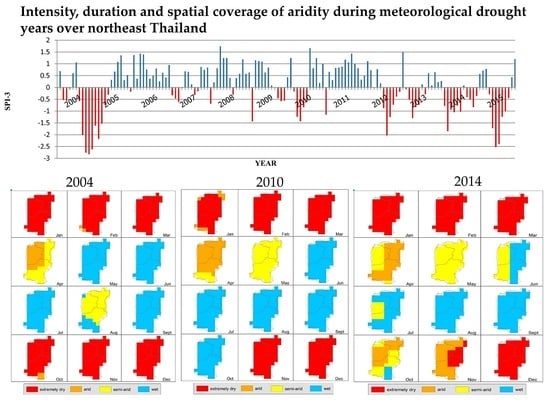Intensity, Duration and Spatial Coverage of Aridity during Meteorological Drought Years over Northeast Thailand
Abstract
:1. Introduction
2. Study Area
2.1. Cassava and Sugarcane Farming
2.2. Climate
3. Materials and Methods
3.1. Standardized Precipitation Index
3.2. Thornthwaite Aridity Index
4. Results
4.1. Temporal Variation in the Standardized Precipitation Index
4.2. Temporal Variation in the Thornthwaite Aridity Index
4.3. Spatial Variation in the TAI for Meteorological Drought Years
5. Discussion
6. Conclusions
Author Contributions
Funding
Institutional Review Board Statement
Informed Consent Statement
Data Availability Statement
Acknowledgments
Conflicts of Interest
Appendix A
Appendix A.1. Computation of the SPI
- i.
- Mean of precipitation:where N is the number of precipitation observations.
- ii.
- Standard deviation for the precipitation:
- iii.
- Skewness of precipitation:
- iv.
- Conversion of precipitation to lognormal values and the statistics U:
- v.
- Shape and scale parameters of Gamma distribution:
- vi.
- Cumulative probability of an observed precipitation event (based on shape and scale parameters):
- vii.
- As the gamma function is undefined for x = 0 and the distribution of precipitation has a possibility of having zeros, the cumulative probability becomes:where q is the probability of zero.
- viii.
- The cumulative probability is transformed to the standard normal variable with a mean of zero and a variance of one, and that is the SPI (using approximate conversion):where,
References
- Belal, A.A.; El-Ramady, H.R.; Mohamed, E.S.; Saleh, A.M. Drought risk assessment using remote sensing and GIS techniques. Arab. J. Geosci. 2014, 7, 35–53. [Google Scholar] [CrossRef]
- National Drought Mitigation Centre. Why Is Drought Important? (Fact Sheet); University of Nebraska: Lincoln, NE, USA, 2006; Available online: http://drought.unl.edu/ (accessed on 5 May 2019).
- Byun, H.-R.; Wilhite, D.A. Objective Quantification of Drought Severity and Duration. J. Clim. 1999, 32, 2747–2756. [Google Scholar] [CrossRef]
- Wang, F.; Zhang, J. Arid/humid patterns over Asia in response to national committed emission reductions under the Paris Agreement. Prog. Earth Planet. Sci. 2020, 7, 11. [Google Scholar] [CrossRef]
- Adel, E.; Magdy, M. Impact of climate change on arid lands agriculture. Agric. Food Secur. 2012, 1, 3. [Google Scholar] [CrossRef]
- Intergovernmental Panel on Climate Change. Technical Summary. In Climate Change 2022: Impacts, Adaptation and Vulnerability. Contribution of Working Group II to the Sixth Assessment Report of the Intergovernmental Panel on Climate Change; Pörtner, H.-O., Roberts, D.C., Tignor, M., Poloczanska, E.S., Mintenbeck, K., Alegría, A., Craig, M., Langsdorf, S., Löschke, S., Möller, V., et al., Eds.; Cambridge University Press: Cambridge, UK; New York, NY, USA, 2022; pp. 37–118. [Google Scholar] [CrossRef]
- Vieux, B.T.; Mamadou, L.N.; Ramatoulaye, M.N.; Saïdou, D.; Mariama, N.K.; Amadou, T.D.; Aboubaker, C.B. Spatialization of the climate using aridity indices: Case of agro ecological zone of peanut basin, Senegal. J. Mater. Environ. Sci. 2020, 11, 2106–2122. [Google Scholar]
- Penning de Vries, F.; Ruaysoongnern, S. Multiple Sources of Water for Multiple Purposes in Northeast Thailand; International Water Management Institute: Colombo, Sri Lanka, 2010. [Google Scholar] [CrossRef]
- Choenkwan, S.; Fox, J.M.; Rambo, A.T. Agriculture in the Mountains of Northeastern Thailand: Current Situation and Prospects for Development. Mt. Res. Dev. 2014, 34, 95–106. [Google Scholar] [CrossRef]
- World Bank. Thailand Environment Monitor: Integrated Water Resources Management—A Way Forward. 2011. Available online: http://documents.worldbank.org/curated/en/2011/06/14600150/thailand-environment-monitor-integrated-water-resources-management-way-forward (accessed on 5 February 2019).
- Yu, Z.; Jianhong, N.; Sizhu, Z. Sustainability of Sugarcane and Cassava-based Fuel-ethanol Production in China. Int. J. Agric. Res. 2012, 7, 457–469. [Google Scholar] [CrossRef]
- IMARC Group. Cassava Processing Market: Global Industry Trends, Share, Size, Growth, Opportunity and Forecast 2021–2026. 2021. Available online: https://www.imarcgroup.com/cassava-processing-plant (accessed on 18 September 2022).
- Expert Market Research. Global Cassava Processing Market Outlook (2017–2027). Available online: https://www.expertmarketresearch.com/reports/cassava-processing-market/toc (accessed on 18 September 2022).
- Charles, O.; Wilhelm, G.; Morag, F.; Hervé, V. Morpho-physiological and molecular evaluation of drought tolerance in 504 cassava (Manihot esculenta Crantz). Field Crops Res. 2020, 255, 107861. [Google Scholar] [CrossRef]
- Samwel, K.M.; Valentine, O.N.; Leena, T.; Jaindra, N.T. Mechanisms and approaches towards enhanced drought tolerance in cassava (Manihot esculenta). Curr. Plant Biol. 2021, 28, 100227. [Google Scholar] [CrossRef]
- Qi, L.; Sasa, X.; Xiaowen, Z.; Yue, L.; Yuanjun, X.; Jicao, D.; Beilei, W.; Yunchang, P.; Weixing, D.; Ziting, W. Drought Sensitivity of Sugarcane Cultivars Shapes Rhizosphere Bacterial Community Patterns in Response to Water Stress. Front. Microbiol. 2020, 2, 732989. [Google Scholar] [CrossRef]
- Ekasingh, B.; Sungkapitux, C.; Kitchaicharoen, J.; Suebpongsang, P. Cassava and Sugarcane. In The Development of Competitive Commercial Agriculture in the Northeast of Thailand, 1950–2006: A Review; The Multiple Cropping Centre, Faculty of Agriculture, Chiang Mai University: Chiang Mai, Thailand, 2007; pp. 63–93. [Google Scholar]
- Hao, Z.; Singh, V.P.; Xia, Y. Seasonal Drought Prediction: Advances, Challenges, and Future Prospects. Rev. Geophys. 2018, 56, 108–141. [Google Scholar] [CrossRef]
- Van Loon, A.F.; Van Lanen, H.A.J. A process-based typology of hydrological drought. Hydrol. Earth Syst. Sci. 2012, 16, 1915–1946. [Google Scholar] [CrossRef]
- Moral, F.J.; Paniagua, L.L.; Rebollo, F.J. Spatial analysis of the annual and seasonal aridity trends in Extremadura, 518 southwestern Spain. Appl. Clim. 2017, 130, 917–932. [Google Scholar] [CrossRef]
- Wiréhn, L. Climate indices for the tailoring of climate information—A systematic literature review of Swedish forestry and agriculture. Clim. Risk Manag. 2021, 34, 100370. [Google Scholar] [CrossRef]
- Sriroth, K.; Rojanaridpiched, C.; Vichukit, V.; Suriyapan, P.; Oates, C. Present Situation and Future Potential of Cassava in Thailand in Cassava’s potential in Asia in the 21st Century: Present situation and future research and development needs. In Proceedings of the Sixth Regional Workshop, Ho Chi Minh City, Vietnam, 21–25 February 2000; Howeler, R.H., Tan, S.L., Eds.; Centro Internacional de Agricultura Tropical (CIAT): Rome, Italy; Cassava Office for Asia: Hong Kong, 2001; pp. 25–46. [Google Scholar]
- Barnaud, C.; Trebuil, G.; Dufumier, M.; Suphanchaimart, N. Rural poverty and diversification of farming systems in upper northeast Thailand. Soc. Sci. Res. Southeast Asia 2006, 9, 157–187. [Google Scholar] [CrossRef]
- Martin, S.A.; Ritchie, R.J. Sourcing Thai Geography Literature for ASEAN and International Education. Singap. J. Trop. Geogr. 2019, 41, 61–85. [Google Scholar] [CrossRef]
- Rayasawath, C. Factors Affecting the Household Succession in Agricultural Occupation in Nakhon Ratchasima Province, Thailand. Agriculture 2018, 8, 109. [Google Scholar] [CrossRef]
- Ratanawahara, C.; Senanarong, N.; Suriyapan, P. Status of Cassava in Thailand: Implication for Future Research and Development, in Cassava in Asia; Ministry of Agriculture and Cooperatives: Bangkok, Thailand, 2000. [Google Scholar]
- Phien, H.N.; Arbhabhirama, A.; Sunchindah, A. Rainfall distribution in northeastern Thailand. Hydrol. Sci. Bull. 2019, 25, 167–182. [Google Scholar] [CrossRef]
- Thailand Meteorological Department. The Climate of Thailand (1981–2010). Available online: https://www.tmd.go.th/en/archive/thailand_climate.pdf (accessed on 10 April 2019).
- Regional Climate Change Assessment Knowledge Platform for Asia. Assessment of Capacity Gaps and Needs of South East Asia Countries in Addressing Impacts, Vulnerability and Adaptation to Climate Variability and Climate Change: Bangkok, Thailand. 2011. Available online: www.asiapacificadapt.net (accessed on 20 April 2019).
- Thai Health. Severe Drought Followed by Devastating Floods: Preparedness for Climate Change. 2011. Available online: http://www.hiso.or.th/hiso/picture/reportHealth/ThaiHealth2011/eng2011_15.pdf (accessed on 5 February 2019).
- Limsakul, A.; Singhruck, P. Long-term trends and variability of total and extreme precipitation in Thailand. Atmos. Res. 2006, 169, 301–317. [Google Scholar] [CrossRef]
- Interrisk Asia. Drought Report, Thailand 2016; InterRisk Asia (Thailand) Co., Ltd.: Bangkok, Thailand, 2016; Available online: http://www.interriskthai.co.th/wp-content/uploads/2017/12/16-005-Drought-20160318.pdf (accessed on 5 February 2019).
- Naruchaikusol, S. Climate Change and Its Impact in Thailand: A Short Overview on Actual and Potential Impacts of the Changing Climate in Southeast Asia (Fact Sheet); TransRe: Bonn, Germany, 2016; Available online: http://www.transre.org/files/3114/6522/5151/Climate_Change_in_Thailand_TransRe_Fact_Sheet_No.2.pdf (accessed on 20 April 2019).
- Dibesh, K.; Mukand, S.B.; Matthew, C.; Sangam, S.; Salvatore, G.P.V.; Albert, S.C. Projected changes in the near-future mean climate and extreme climate events in northeast Thailand. Int. J. Climatol. 2021, 42, 2470–2492. [Google Scholar] [CrossRef]
- Beaudoing; Hiroko; Rodell, M. NASA/GSFC/HSL, GLDAS Noah Land Surface Model L4 Monthly 0.25 × 0.25 Degree V2.1; Goddard Earth Sciences Data and Information Services Center (GES DISC): Greenbelt, MD, USA, 2016. [Google Scholar] [CrossRef]
- Kumar, M.N.; Murthy, C.S.; Sesha Sai, M.V.R.; Roy, P.S. On the use of Standardized Precipitation Index (SPI) for drought intensity assessment. Meteorol. Appl. 2009, 16, 381–389. [Google Scholar] [CrossRef]
- Svoboda, M.D.; Fuchs, B.A. Handbook of Drought Indicators and Indices; Integrated Drought Management Programme (IDMP), Drought Mitigation Center Faculty Publications, University of Nebraska: Lincoln, NE, USA, 2016. [Google Scholar]
- Gebremedhin, M.A.; Kahsay, G.H.; Fanta, H.G. Assessment of spatial distribution of aridity indices in Raya valley, northern Ethiopia. Appl. Water Sci. 2018, 8, 217. [Google Scholar] [CrossRef]
- Zargar, A.; Sadiq, R.; Naser, B.; Khan, F.I. A review of drought indices. Environ. Rev. 2011, 19, 333–349. [Google Scholar] [CrossRef]
- Xia, L.; Zhao, F.; Mao, K.; Yuan, Z.; Zuo, Z.; Xu, T. SPI-Based Analyses of Drought Changes over the Past 60 Years in China’s Major Crop-Growing Areas. Remote Sens. 2018, 10, 171. [Google Scholar] [CrossRef]
- Sábitz, J.; Pongrácz, R.; Bartholy, J. Estimated changes of drought tendency in the Carpathian Basin. Hung. Geogr. Bull. 2014, 63, 365–378. [Google Scholar] [CrossRef]
- Thornthwaite, C.W. An approach towards a rational classification of climate. Geogr. Rev. 1948, 38, 55–94. [Google Scholar] [CrossRef]
- McKee, T.B.; Doesken, N.J.; Kleist, J. The relationship of drought frequency and duration to time scales. In Proceedings of the 8th Conference on Applied Climatology, Anaheim, CA, USA, 17–22 January 1993; pp. 179–184. [Google Scholar]
- Dlamini, T.; Songsom, V. Landsat-based drought phenomenon evaluation of cassava and sugar cane in northeast Thailand. J. Eng. Sci. Res. 2019, 3, 6–13. [Google Scholar] [CrossRef]
- Dutta, D.; Kundu, A.; Patel, N.R.; Saha, S.K.; Siddiqui, A.R. Assessment of agricultural drought in Rajasthan (India) using remote sensing derived Vegetation Condition Index (VCI) and Standardized Precipitation Index (SPI). Egypt. J. Remote Sens. Space Sci. 2015, 18, 53–63. [Google Scholar] [CrossRef] [Green Version]
- Grandstaff, T.B.; Grandstaff, S.; Limpinuntana, V.; Suphanchaimat, N. Rainfed revolution in Northeast Thailand. Southeast Asian Stud. 2008, 46, 289–376. [Google Scholar]
- Rojanaridpiched, C.; Sriroth, K. Present situation and future potential of cassava in Thailand. In Proceedings of the Regional Cassava Stakeholders Consultation Meeting, Bangkok, Thailand, 23–25 November 1998. [Google Scholar]
- Inman-Bamber, N.; Smith, D. Water relations in sugarcane and response to water deficits. Field Crops Res. 2005, 92, 185–202. [Google Scholar] [CrossRef]
- Cock, J.H. Sugarcane growth and development. Int. Sugar J. 2003, 105, 540–552. [Google Scholar]
- Ferreira, T.; Tsunada, M.S.; Bassi, D.; Araújo, P.; Mattiello, L.; Guidelli, G.V.; Menossi, M. Sugarcane Water Stress Tolerance Mechanisms and Its Implications on Developing Biotechnology Solutions. Front. Plant Sci. 2017, 8, 1077. [Google Scholar] [CrossRef]
- Ouyyanont, P. Rural Thailand: Change and Continuity. In Trends in Southeast Asia; Tiong, T.N., Oh, S., Beng, O.K., Chong, T., Hutchinson, F.E., Singh, D., Nair, V., Li, K.P.J., Eds.; ISEAS-Yusof Ishak Institute: Singapore, 2016; Volume 8, pp. 12–20. [Google Scholar]
- Robert, M.; Thomas, M. Aridity and drought. In Arid Lands, Water Evaluation and Management: Environmental Science and Engineering; Springer: Berlin/Heidelberg, Germany, 2012; pp. 21–39. [Google Scholar] [CrossRef]
- Mandakh, N.; Qi, F.; Ravinesh, D. A comparative Study of temperature and precipitation-based aridity indices and their trends in Mongolia. Int. J. Environ. Res. 2018, 12, 887–899. [Google Scholar] [CrossRef]
- Thaiturapaisan, T. Drought, a Worrying Situation for Thai Agriculture. Available online: https://www.scbeic.com/en/detail/product/1429 (accessed on 10 April 2019).
- Kheoruenromne, I.; Suddhiprakarn, A.; Kanghae, P. Properties, Environment and Fertility Capability of Sandy Soils in Northeast Plateau, Thailand. Kasetsart J. Nat. Sci. 1998, 32, 355–373. [Google Scholar]
- Nobe, A.D.; Ruaysoongnern, S. Soil Degradation under Long-Term Rice Production in Northeast Thailand. 2019. Available online: http://www.mcc.cmu.ac.th/Seminar/pdf/1361.pdf (accessed on 20 February 2020).
- Floch, P.; Molle, F. Irrigated agriculture and rural change in northeastern Thailand: Reflections on present developments. In Governing the Mekong: Engaging in the Politics of Knowledge; Daniel, R., Lebel, L., Manorom, K., Eds.; Strategic Information and Research Development Center (SRID): Petaling Jaya, Malaysia, 2013; pp. 185–198. [Google Scholar]
- Lamm, R.F. Advantages and disadvantages of subsurface drip irrigation. In Proceedings of the International Meeting on Advances in Drip/Micro Irrigation, Puerto de La Cruz, Tenerife, Spain, 2–5 December 2002; Instituto Canario de Investigaciones Agrarias: Tenerife, Spain, 2002. [Google Scholar]

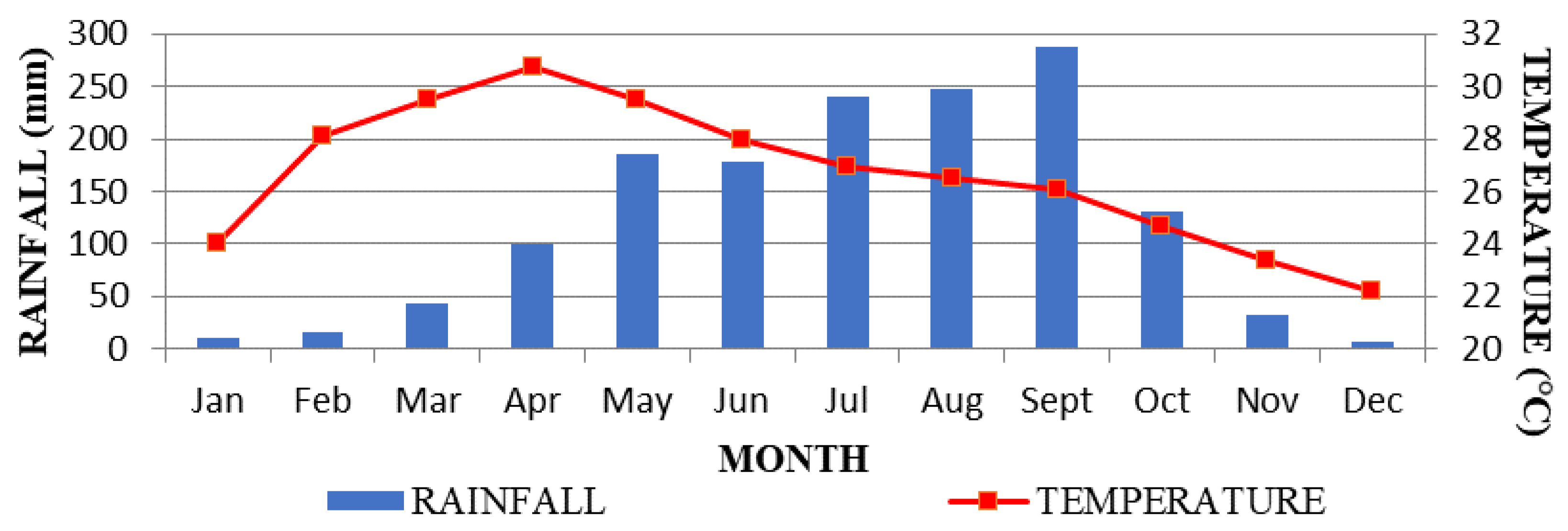




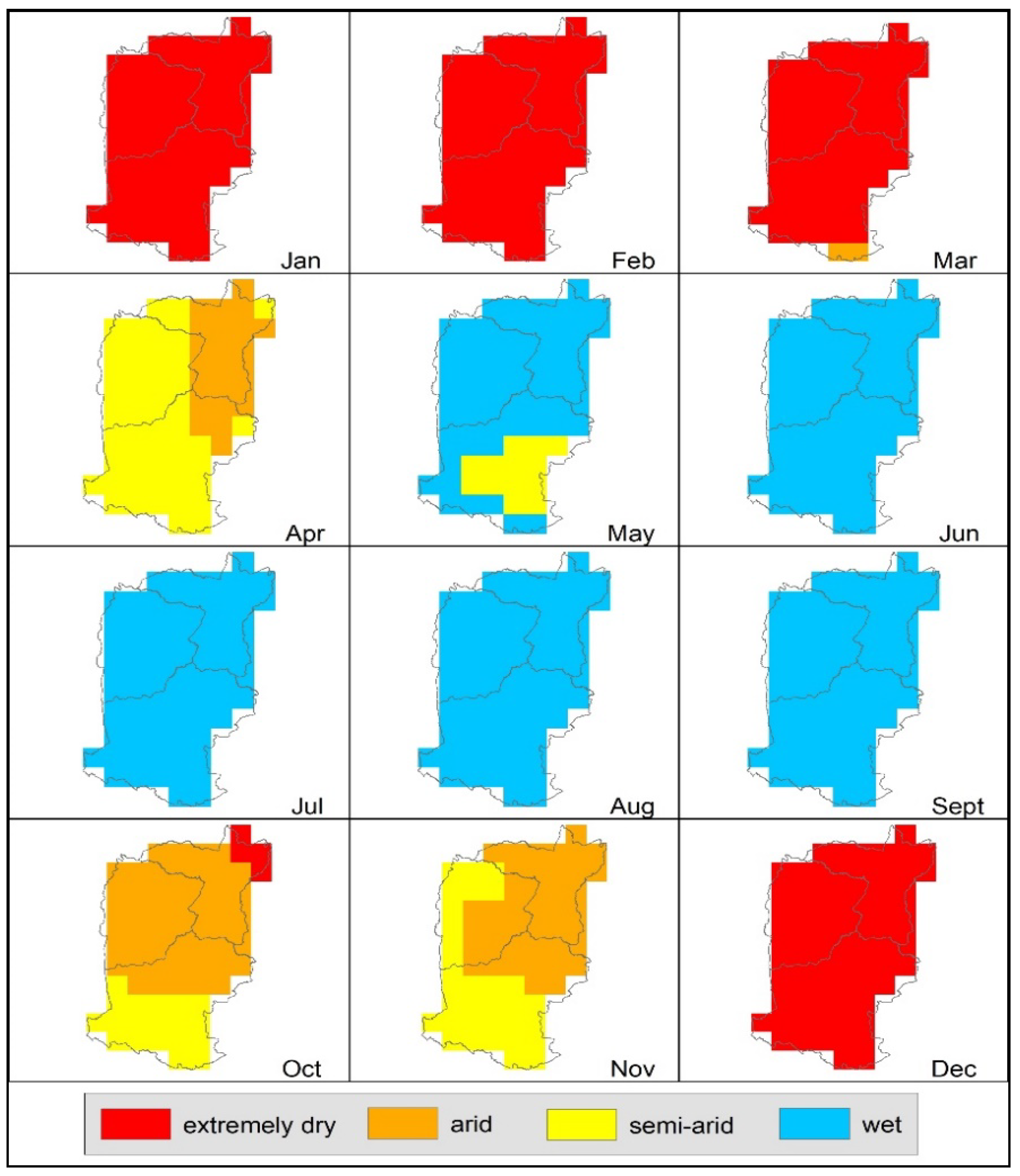

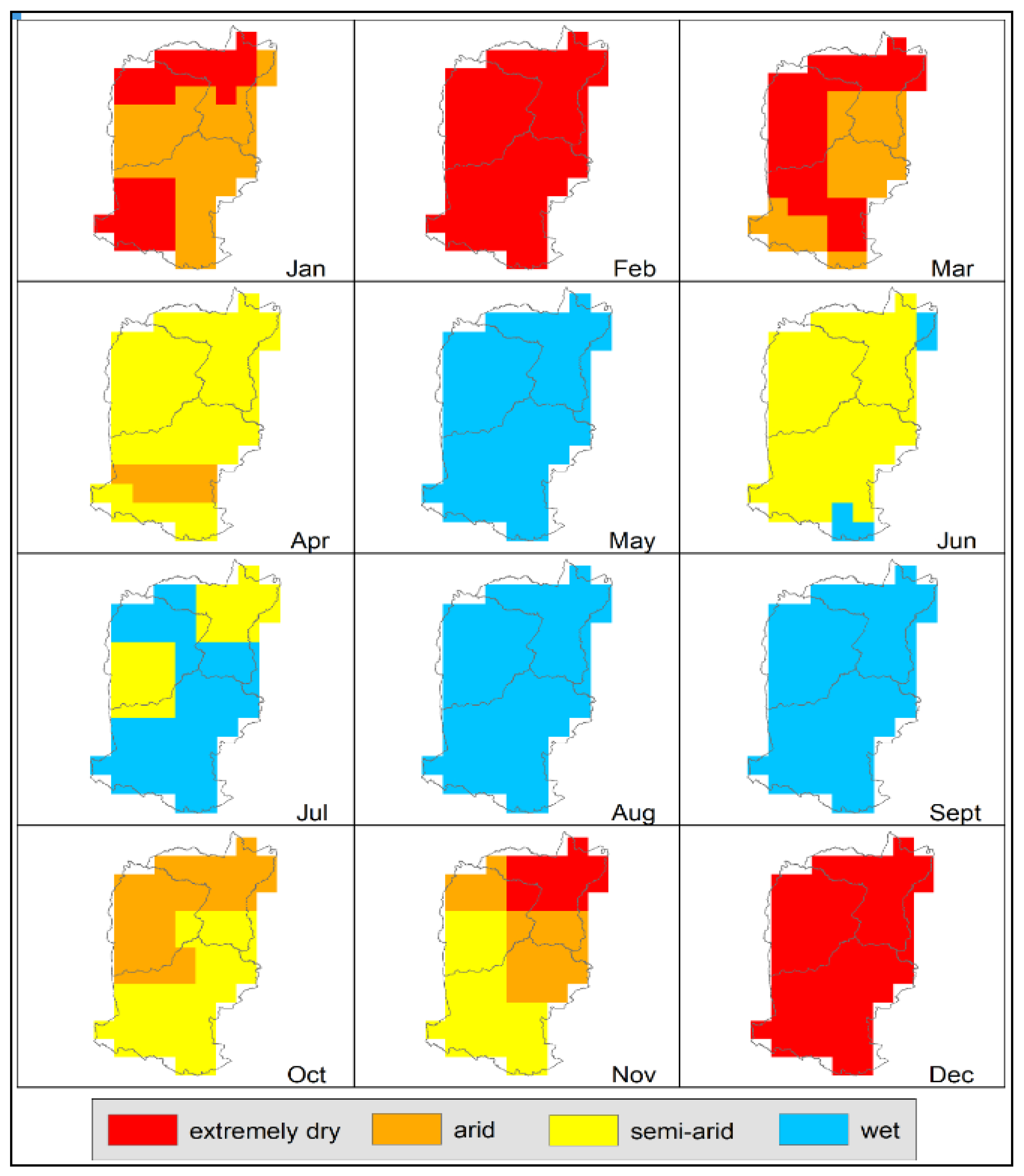

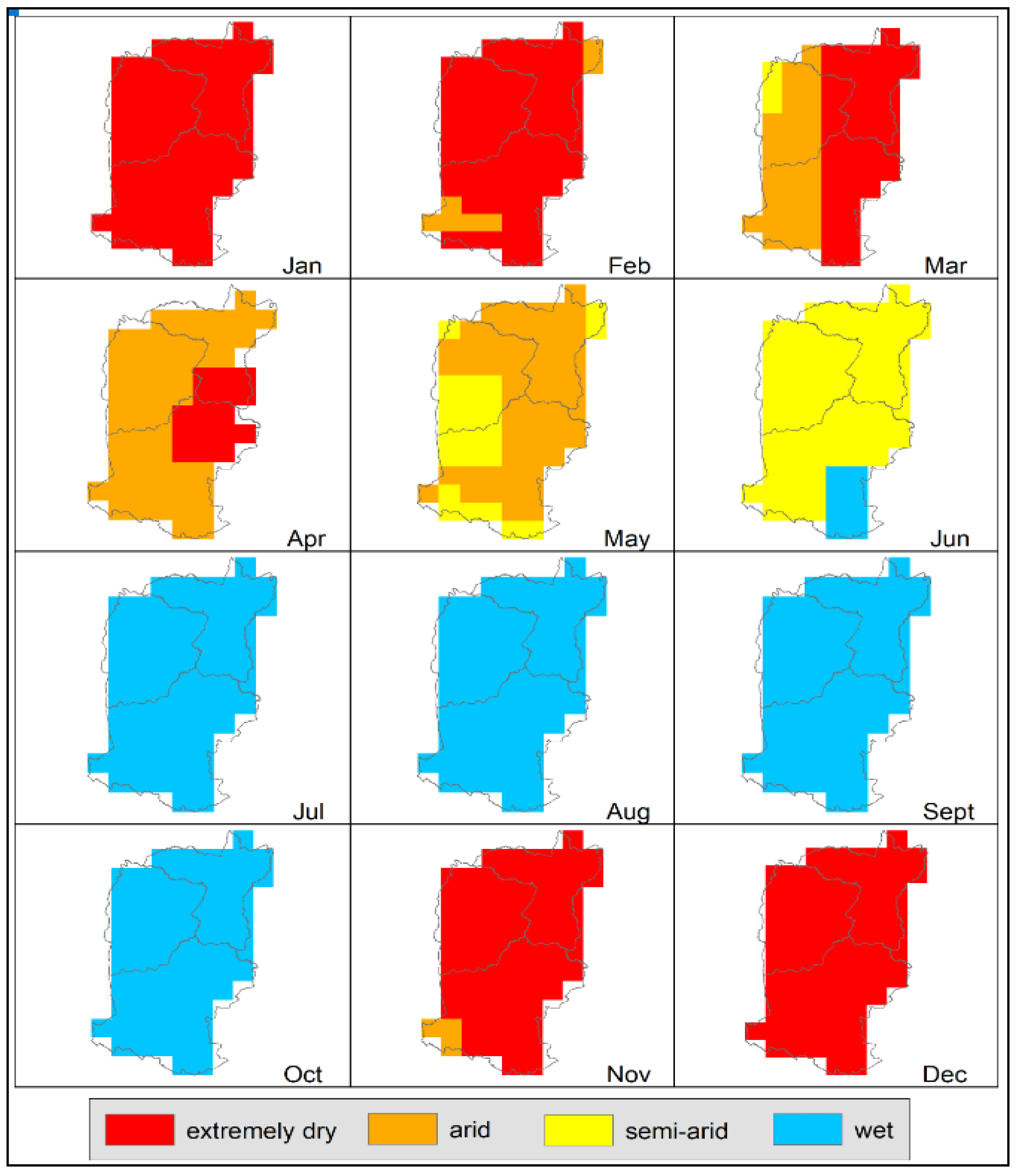
| SPI Duration | Phenomena Reflected | Application |
|---|---|---|
| 1 month | Short-term conditions | Short-term moisture and crop stress |
| 3 months | Short- and medium-term moisture conditions | Seasonal estimation of precipitation |
| 6 months | Medium-term trends in precipitation | Precipitation for different seasons |
| SPI | Level |
|---|---|
| ≥−2 | Extremely wet |
| 1.50 to 1.99 | Very wet |
| 1.00 to 1.49 | Moderately wet |
| −0.99 to 0.99 | Near normal |
| −1.49 to −1.00 | Moderately dry |
| −1.99 to −1.50 | Severely dry |
| ≤−2 | Extremely dry |
| TAI Scale | Level |
|---|---|
| >6.4 | Wet |
| 3.2 to 6.4 | Semi-arid |
| 1.6 to 3.2 | Arid |
| <1.6 | Extremely dry |
Publisher’s Note: MDPI stays neutral with regard to jurisdictional claims in published maps and institutional affiliations. |
© 2022 by the authors. Licensee MDPI, Basel, Switzerland. This article is an open access article distributed under the terms and conditions of the Creative Commons Attribution (CC BY) license (https://creativecommons.org/licenses/by/4.0/).
Share and Cite
Dlamini, T.; Songsom, V.; Koedsin, W.; Ritchie, R.J. Intensity, Duration and Spatial Coverage of Aridity during Meteorological Drought Years over Northeast Thailand. Climate 2022, 10, 137. https://doi.org/10.3390/cli10100137
Dlamini T, Songsom V, Koedsin W, Ritchie RJ. Intensity, Duration and Spatial Coverage of Aridity during Meteorological Drought Years over Northeast Thailand. Climate. 2022; 10(10):137. https://doi.org/10.3390/cli10100137
Chicago/Turabian StyleDlamini, Tenanile, Veeranun Songsom, Werapong Koedsin, and Raymond J. Ritchie. 2022. "Intensity, Duration and Spatial Coverage of Aridity during Meteorological Drought Years over Northeast Thailand" Climate 10, no. 10: 137. https://doi.org/10.3390/cli10100137
APA StyleDlamini, T., Songsom, V., Koedsin, W., & Ritchie, R. J. (2022). Intensity, Duration and Spatial Coverage of Aridity during Meteorological Drought Years over Northeast Thailand. Climate, 10(10), 137. https://doi.org/10.3390/cli10100137







